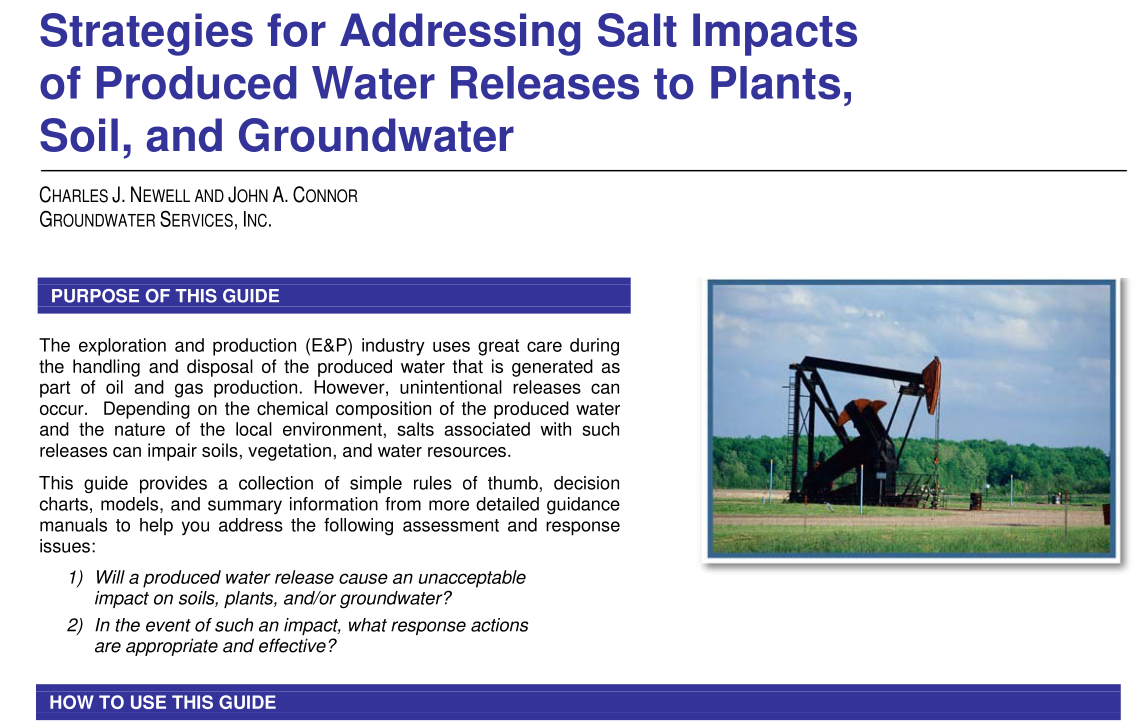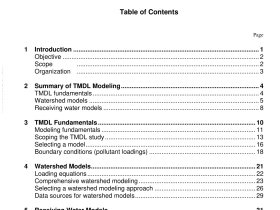API Publ 4758 pdf download

API Publ 4758 pdf download.Strategies for Addressing Salt Impacts of Produced Water Releases to Plants, Soil, and Groundwater
The exploration and production (E&P) industry uses great care during the handling and disposal of the produced water that is generated as part of oil and gas production. However, unintentional releases can occur. Depending on the chemical composition of the produced water and the nature of the local environment, salts associated with such releases can impair soils, vegetation, and water resources. This guide provides a collection of simple rules of thumb, decision charts, models, and summary information from more detailed guidance manuals to help you address the following assessment and response issues: 1) Will a produced water release cause an unacceptable impact on soils, plants, and/or groundwater? 2) In the event of such an impact, what response actions are appropriate and effective?
Information from API Publication 4663, Remediation of Salt-Affected Soils at Oil and Gas Production Facilities and other sources was compiled to develop the following “Rules of Thumb” for response to impacts by produced water. Each Rule of Thumb describes a set of conditions associated with a produced water release and the typical response to such conditions. These Rules of Thumb are for typical rangeland and farmland areas, but may not be applicable to environments with naturally high salinity. For further discussion of conditions not covered by these Rules of Thumb, please go to page 4.
The following Rules of Thumb for response to groundwater impacts by produced water were developed as guidance using information from API Publication 4734, Modeling Study of Produced Water Release Scenarios. In that study, the authors performed several hundred computer simulations with the HYDRUS-1 D model to determine the sensitivity of groundwater underlying a produced water release to various factors such as release volume, chloride concentration of the produced water, depth to groundwater, soil type, rainfall and hydrology of the area, and other factors. Each Rule of Thumb describes a set of site conditions associated with a produced water release and assesses the likelihood of an impact to groundwater. These Rules of Thumb may not be applicable to environments with naturally high salinity or areas with multiple releases over several years. For cases not covered by these Rules of Thumb, go to page 9.
Key assumptions and limitations of the Planning Model include: 1 ) salts are mixed evenly throughout the soil; 2) the percentage of the rainfall that infiltrates through the soil to groundwater is proportional to the amount of rainfall; 3) the recharge rate is the 80 th percentile of recharge rates from data compiled from API Publication 4643; 4) almost all the salts in affected soils can be flushed out with 1 2 inches of recharge (from API 4663); 5) no capillary effects, evaporation, or other transport processes except advection, mixing, and dispersion in the saturated zone are present; 6) no density effects are assumed in transport of chloride in groundwater; 7) salt is mixed throughout the water-bearing unit; 8) a 2x safety factor is assumed; and 9) potential impacts only apply to the uppermost water-bearing unit, and NOT to deeper, regional aquifers. When applied to site conditions presented in API Publication 4734, the Planning Model was more likely to show higher chloride concentrations in groundwater than chloride concentrations predicted by HYDRUS, a much more sophisticated leaching model.Other approaches can also be used to provide more accurate estimates of chloride migration. Key resources include: • API Publication 4734: In this study, the authors performed several hundred computer simulations with the HYDRUS model to determine the sensitivity of groundwater underlying a produced water release to various factors such as release volume, chloride concentration of the produced water, depth to groundwater, soil type, rainfall and hydrology of the area, and other factors. Review of this document can provide additional information regarding the impact of produced water releases on groundwater. • More Detailed Computer Models: Models such as VADSAT or HYDRUS can be applied to investigate potential groundwater impacts from produced water releases. • Site Investigation: A groundwater site investigation involving the collection of groundwater samples from monitoring wells or direct push sampling techniques can show if a produced water release has actually affected groundwater at a given site.









